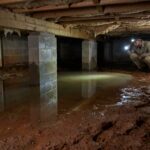Essential Guide to Foundation Repair: Safeguarding Your Home’s Stability and Value
When it comes to homeownership, few things are as crucial as the foundation of your home. It serves as the bedrock of your investment, quite literally! However, just like a superhero in a good comic book, even the strongest foundations can face challenges. Over time, various factors can compromise your foundation, leading to structural issues that can affect the integrity and value of your home. This essential guide will walk you through the intricacies of foundation repair, providing the knowledge you need to safeguard your dwelling from the lurking perils below.
Understanding the Foundation
Before diving into the repair aspect, let’s take a moment to appreciate what we’re working with. Foundations come in several types, primarily including:
1. **Basement Foundations**: These are popular in areas with a stable water table, providing extra living space and storage.
2. **Crawl Space Foundations**: Typically found in regions with high moisture, these allow for ventilation and easy access to plumbing.
3. **Slab-on-Grade Foundations**: These are common in warmer climates, where a continuous concrete slab is poured directly on the ground.
Each type serves its purpose, but they can all fall victim to similar issues, such as soil movement, water damage, or poor construction practices.
Common Foundation Issues
Now that we have a grasp of the different foundation types, let’s move on to some notorious problems that can arise:
1. **Cracks in Walls and Floors**: A crack can be more than just an eyesore; it might indicate serious underlying problems. Horizontal cracks often point to pressure from expanding soil, while vertical cracks may be signs of settling.
2. **Water Intrusion**: Water is a sneaky adversary. Foundations can become compromised due to leaking gutters, poor drainage, or even underground springs. The consequences? Mold growth and structural damage.
3. **Uneven Floors or Door Misalignment**: If your home feels like a funhouse, with slanted floors and stubborn doors that refuse to open, it’s likely a sign that your foundation needs attention.
4. **Bowing or Leaning Walls**: Walls that lean inwards or bow outwards can be a significant red flag, indicating pressure applied by shifting soil.
Recognizing the Symptoms Early
When it comes to foundation issues, early detection is key. Here’s what to look for:
– **Interior Signs**: Look for cracking in drywall, sticking doors and windows, or gaps around frames.
– **Exterior Signs**: Check for cracks in the brickwork, leaning chimneys, or displacement of exterior steps.
– **Landscape Changes**: Significant changes in the landscape around your home, such as eroded soil or new depressions, can signify foundation problems.
If you notice any of these symptoms, don’t ignore them! Think of them as your home’s way of sending an SOS signal.
The Importance of Timely Repair
Ignoring foundation problems is akin to ignoring a leaky roof. You may think, “It’s not too bad,” but soon, you’ll find yourself swimming in a sea of repairs and additional costs. Addressing these issues promptly not only saves you money but also protects your home’s value. A well-maintained foundation enhances curb appeal and ensures that you won’t have to sell your home at a loss due to significant repairs down the road.
Foundation Repair Methods: The Tools of the Trade
When it comes to fixing a damaged foundation, professionals have various methods and tools at their disposal. Here are some of the most common techniques:
1. **Piering or Piling**: This method involves inserting steel piers or piles deep into the ground to support the foundation. It’s like giving your house a sturdy pair of legs to stand on.
2. **Slabjacking**: For homes with a concrete slab foundation, slabjacking involves pumping a mixture under the slab to raise and level it back to its original position. It’s essentially a “mini lift” for your foundation!
3. **Wall Anchors**: If walls are bowing or leaning, installing wall anchors can help pull them back into place. Think of it as giving your wall a reassuring hug.
4. **Drainage Systems**: Sometimes, the best solution is prevention. Installing proper drainage systems can divert water away from the foundation, reducing pressure and moisture levels.
5. **Vapor Barriers**: In crawl spaces, vapor barriers help seal off moisture from the ground, keeping the area dry and reducing the likelihood of mold growth. It’s like putting a raincoat on your foundation.
Choosing the Right Professionals
While DIY enthusiasts may feel inclined to tackle foundation repairs themselves, this is generally not recommended. Foundation issues can be complex, and it’s often best to enlist the help of professionals who specialize in foundation repair. Here are a few tips for choosing the right contractor:
– **Research and Reviews**: Start by researching local contractors and checking reviews. Look for those with a proven track record of successful foundation repairs.
– **Free Estimates**: Most reputable contractors will offer free estimates. Use this opportunity to ask questions and get a feel for their expertise.
– **Get Multiple Quotes**: Don’t settle on the first quote you receive. Getting multiple estimates allows you to understand the market rate and choose a contractor who offers the best value.
– **Check Credentials**: Ensure your chosen contractor is licensed and insured. This protects you from liability in case of accidents during the repair process.
– **Ask for References**: A solid contractor should be able to provide references from past clients. Reach out to these references to hear about their experiences.
Prevention: The Best Medicine
After navigating the world of foundation repair, you might be wondering how to prevent these issues from cropping up again. Here are some preventive measures to consider:
1. **Maintain Gutters and Downspouts**: Keep gutters clean and ensure downspouts direct water away from the foundation. A little upkeep goes a long way!
2. **Assess Landscaping**: Ensure that your landscaping slopes away from your home. This will help redirect water rather than allowing it to pool around the foundation.
3. **Monitor Water Usage**: Excessive watering can weaken soil and cause shifting. Maintain an appropriate amount of moisture around your home.
4. **Inspect for Cracks Regularly**: Routine inspections of both your interior and exterior can help catch problems early before they escalate.
5. **Install French Drains**: In areas prone to water accumulation, French drains can be invaluable. They work by redirecting water away from your home, protecting your foundation like an invisible guardian.
Conclusion
Your home is an investment, and its foundation is the cornerstone of that investment. By understanding the common issues that can arise, recognizing symptoms early, and knowing when to call in the experts, you can effectively safeguard your home from the inevitable wear and tear of time. Remember, whether it’s opting for piering or simply maintaining gutters, every action contributes to the stability and value of your property. With the right knowledge and proactive measures, you can keep your home standing tall, no matter how tumultuous the storms of life may become. So go ahead, take a peek at that foundation – it just might be the unsung hero of your household!


